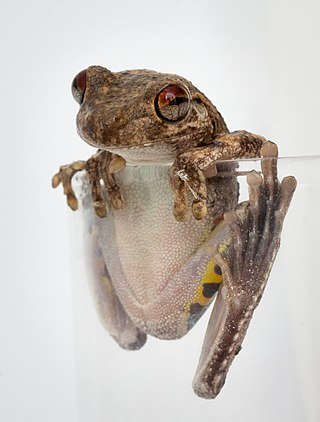
Hylidae is a wide-ranging family of frogs commonly referred to as "tree frogs and their allies". However, the hylids include a diversity of frog species, many of which do not live in trees, but are terrestrial or semiaquatic.

Litoria is a genus of hylid tree frogs, sometimes collectively referred to as Australasian treefrogs.

The white-lipped tree frog is a species of frog in the subfamily Pelodryadinae. It is the world's largest tree frog and is found in Australia. Other common names include the New Guinea treefrog, giant tree frog, and Australian giant treefrog.

Roth's tree frog, or the northern laughing tree frog, is a species of tree frog native to northern Australia and southern Papua New Guinea. Roth's tree frog is a common frog, closely related to Peron's tree frog and Tyler's tree frog.

The Australian waterfall frog or torrent treefrog is a species of tree frog native to Far North Queensland, Australia. The common name "waterfall frog" is indicative of its habitat of moist, rocky streams, and is often found along waterfalls within its range.
The Cooloola sedge frog or Cooloola tree frog is a species of frog in the subfamily Pelodryadinae.

The green-eyed treefrog is a species of Australasian treefrog in the subfamily Pelodryadinae that occurs in the Wet Tropics of Australia.
The Wendessi tree frog is a species of frog in the subfamily Pelodryadinae.
The Moaif tree frog is a species of frog in the subfamily Pelodryadinae, endemic to West Papua, Indonesia. Its natural habitat is subtropical or tropical moist lowland forests.
Djoko Tjahjono Iskandar is an Indonesian herpetologist who studies the amphibians of Southeast Asia and Australasia. He is a professor of biosystematics and ecology at Bandung Institute of Technology in West Java, Indonesia.
Litoria bibonius is a species of frog of the subfamily Pelodryadinae.
The Pinocchio frog or northern Pinocchio treefrog is a species of frog in the subfamily Pelodryadinae. It was discovered in the Foja Mountains of Papua Province in Indonesia by Conservation International and the National Geographic Society during a 2008 expedition, where it was accidentally spotted by Paul Oliver, a herpetologist. Despite being discovered in 2008, it remained undescribed and was long known simply as the "Pinocchio frog" until 2019, when it was finally described as Litoria pinocchio. The frog is named for its Pinocchio-like nose, which can enlarge and inflate in certain situations. Although unusual, a similar nose is found in several other related frogs from New Guinea, including L. chrisdahli, L. havina, L. mareku, L. mucro, L. pronimia and L. prora.
Nyctimystes dux is a species of frog in the subfamily Pelodryadinae. This fairly large tree frog is mainly green. It is endemic to the Huon Peninsula in Papua New Guinea. It was separated from Litoria graminea by Richards & Oliver, 2006.

Pelodryadinae, also known as Australian treefrogs, is a subfamily of frogs found in the region of Australia and New Guinea, and have also been introduced to New Caledonia, Guam, New Zealand, and Vanuatu.
Nyctimystes pallidofemora is a species of tree frog in the subfamily Pelodryadinae, endemic to Papua New Guinea. Scientists disagree about whether this frog is best placed in the genus Nyctimystes or the genus Litoria.
Nyctimystes nullicedens is a species of tree frog in the subfamily Pelodryadinae. It is endemic to Papua New Guinea and has been found on the south-western side of Mount Obree, at 550 meters above sea level.
Litoria aplini, or Aplin's tree frog, is a species of frog in the family Hylidae endemic to Papua New Guinea. Scientists know it exclusively from the type locality: the upper reaches of the Sepik River in Sandaun Province.
Litoria richardsi is a species of frog in the family Hylidae, endemic to Papua New Guinea and Indonesia. Scientists have seen it about 80 m above sea level.
Litoria amnicola, the Raja Ampat torrent tree frog, is a frog in the family Hylidae, endemic to Indonesia. It has been found on Salawati Island, which is in the Raja Ampat archipelago.
Litoria naispela, also known as the Crater Mountain treehole frog, is a species of frog in the subfamily Pelodryadinae. It was described in 2023 by Australian herpetologist Stephen Richards and his colleagues Stephen Donnellan and Paul Oliver. The specific epithet naispela is a Tok Pisin term meaning ‘beautiful’ or ‘attractive’.






